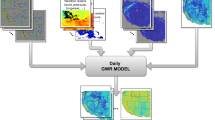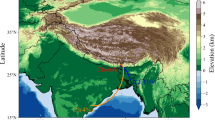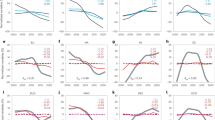Abstract
The spatial and temporal characteristics of fine particulate matter (PM2.5, particulate matter <2.5 μm in aerodynamic diameter) are increasingly being studied from satellite aerosol remote sensing data. However, cloud cover severely limits the coverage of satellite-driven PM2.5 models, and little research has been conducted on the association between cloud properties and PM2.5 levels. In this study, we analyzed the relationships between ground PM2.5 concentrations and two satellite-retrieved cloud parameters using data from the Southeastern Aerosol Research and Characterization (SEARCH) Network during 2000–2010. We found that both satellite-retrieved cloud fraction (CF) and cloud optical thickness (COT) are negatively associated with PM2.5 levels. PM2.5 speciation and meteorological analysis suggested that the main reason for these negative relationships might be the decreased secondary particle generation. Stratified analyses by season, land use type, and site location showed that seasonal impacts on this relationship are significant. These associations do not vary substantially between urban and rural sites or inland and coastal sites. The statistically significant negative associations of PM2.5 mass concentrations with CF and COT suggest that satellite-retrieved cloud parameters have the potential to serve as predictors to fill the data gap left by satellite aerosol optical depth in satellite-driven PM2.5 models.
This is a preview of subscription content, access via your institution
Access options
Subscribe to this journal
Receive 6 print issues and online access
$259.00 per year
only $43.17 per issue
Buy this article
- Purchase on Springer Link
- Instant access to full article PDF
Prices may be subject to local taxes which are calculated during checkout






Similar content being viewed by others
References
Brook RD, Franklin B, Cascio W, Hong YL, Howard G, Lipsett M et al. Air pollution and cardiovascular disease - a statement for healthcare professionals from the expert panel on population and prevention science of the American heart association. Circulation 2004; 109: 2655–2671.
Dominici F, Peng RD, Bell ML, Pham L, McDermott A, Zeger SL et al. Fine particulate air pollution and hospital admission for cardiovascular and respiratory diseases. JAMA 2006; 295: 1127–1134.
Pope CA, Burnett RT, Thun MJ, Calle EE, Krewski D, Ito K et al. Lung cancer, cardiopulmonary mortality, and long-term exposure to fine particulate air pollution. JAMA 2002; 287: 1132–1141.
Kaufman YJ, Herring DD, Ranson KJ, Collatz GJ . Earth Observing System AM1 mission to earth. IEEE Trans Geosci Remote Sens 1998; 36: 1045–1055.
Parkinson CL . Aqua: an earth-observing satellite mission to examine water and other climate variables. IEEE Trans Geosci Remote Sens 2003; 41: 173–183.
Hoff RM, Christopher SA . Remote sensing of particulate pollution from space: have we reached the promised land? J Air Waste Manage Assoc 2009; 59: 645–675.
Kloog I, Koutrakis P, Coull BA, Lee HJ, Schwartz J . Assessing temporally and spatially resolved PM(2.5) exposures for epidemiological studies using satellite aerosol optical depth measurements. Atmos Environ 2011; 45: 6267–6275.
Lee HJ, Liu Y, Coull BA, Schwartz J, Koutrakis P . A novel calibration approach of MODIS AOD data to predict PM(2.5) concentrations. Atmos Chem Phys 2011; 11: 7991–8002.
Liu Y, Paciorek CJ, Koutrakis P . Estimating regional spatial and temporal variability of PM2.5 concentrations using satellite data, meteorology, and land use information. Environ Health Perspect 2009; 117: 886–892.
Dey S, Di Girolamo L, van Donkelaar A, Tripathi SN, Gupta T, Mohan M . Variability of outdoor fine particulate (PM2.5) concentration in the Indian subcontinent: a remote sensing approach. Remote Sens Environ 2012; 127: 153–161.
Gupta P, Christopher SA . Seven year particulate matter air quality assessment from surface and satellite measurements. Atmos Chem Physics 2008; 8: 3311–3324.
Kloog I, Nordio F, Coull BA, Schwartz J . Incorporating local land use regression and satellite aerosol optical depth in a hybrid model of spatiotemporal pm2.5 exposures in the Mid-Atlantic states. Environ Sci Technol 2012; 46: 11913–11921.
Jerrett M, Arain A, Kanaroglou P, Beckerman B, Potoglou D, Sahsuvaroglu T et al. A review and evaluation of intraurban air pollution exposure models. J Expo Anal Environ Epidemiol 2005; 15: 185–204.
Dawson JP, Adams PJ, Pandis SN . Sensitivity of PM2.5 to climate in the Eastern US: a modeling case study. Atmos Chem Physics 2007; 7: 4295–4309.
Tai APK, Mickley LJ, Jacob DJ . Correlations between fine particulate matter (PM2.5) and meteorological variables in the United States: implications for the sensitivity of PM2.5 to climate change. Atmos Environ 2010; 44: 3976–3984.
Chen YJ, Zheng M, Edgerton ES, Ke L, Sheng GY, Fu JM . PM2.5 source apportionment in the southeastern U.S.: spatial and seasonal variations during 2001–2005. J Geophys Res-Atmos 2012; 117: D08304.
Edgerton ES, Hartsell BE, Saylor RD, Jansen JJ, Hansen DA, Hidy GM . The southeastern aerosol research and characterization study: Part II. Filter-based measurements of fine and coarse particulate matter mass and composition. J Air Waste Manage Assoc 2005; 55: 1527–1542.
Lee S, Russell AG, Baumann K . Source apportionment of fine particulate matter in the southeastern united states. J Air Waste Manage Assoc 2007; 57: 1123–1135.
Platnick S, King MD, Ackerman SA, Menzel WP, Baum BA, Riedi JC et al. The MODIS cloud products: algorithms and examples from Terra. IEEE Trans Geosci Remote Sens 2003; 41: 459–473.
Varnai T, Marshak A, Yang W . Multi-satellite aerosol observations in the vicinity of clouds. Atmos Chem Physics 2013; 13: 3899–3908.
Chand D, Wood R, Ghan SJ, Wang MH, Ovchinnikov M, Rasch PJ et al. Aerosol optical depth increase in partly cloudy conditions. J Geophys Res Atmos 2012; 117: D17207.
Hansen DA, Edgerton ES, Hartsell BE, Jansen JJ, Kandasamy N, Hidy GM et al. The southeastern aerosol research and characterization study: Part 1-overview. J Air Waste Manage Assoc 2003; 53: 1460–1471.
Liu Y, Franklin M, Kahn R, Koutrakis P . Using Aerosol Optical Thickness to Predict Ground-Level PM2.5 Concentrations in the St. Louis Area: a Comparison Between MISR and MODIS. Remote Sens Environ 2007; 107: 33–44.
Wang J, Christopher SA . Intercomparison between satellite-derived aerosol optical thickness and PM2.5 mass: Implications for air quality studies. Geophys Res Lett 2003; 30: 2095.
Park RJ, Jacob DJ, Logan JA . Fire and biofuel contributions to annual mean aerosol mass concentrations in the United States. Atmos Environ 2007; 41: 7389–7400.
Stelson AW, Seinfeld JH . Relative-humidity and temperature-dependence of the ammonium-nitrate dissociation-constant. Atmos Environ 1982; 16: 983–992.
Martins JV, Tanre D, Remer L, Kaufman Y, Mattoo S, Levy R . MODIS Cloud screening for remote sensing of aerosols over oceans using spatial variability. Geophysical Res Lett 2002; 29: MOD4-1–MOD04-4.
Remer LA, Kaufman YJ, Tanre D, Mattoo S, Chu DA, Martins JV et al. The MODIS aerosol algorithm, products, and validation. J Atmos Sci 2005; 62: 947–973.
Acknowledgements
This work was partially supported by NASA Applied Sciences Program (grant no. NNX09AT52G, PI: Y Liu). In addition, this publication was made possible by USEPA grant R834799. Its contents are solely the responsibility of the grantee and do not necessarily represent the official views of the USEPA. Further, USEPA does not endorse the purchase of any commercial products or services mentioned in the publication. The work of Chao Yu was supported by the China Scholarship Council (CSC) under the State Scholarship Fund. We thank Dr. Steven Platnick and Jerusha Barton for their technical support.
Author information
Authors and Affiliations
Corresponding author
Ethics declarations
Competing interests
The authors declare no conflict of interest.
Additional information
Supplementary Information accompanies the paper on the Journal of Exposure Science and Environmental Epidemiology website
Supplementary information
Rights and permissions
About this article
Cite this article
Yu, C., Di Girolamo, L., Chen, L. et al. Statistical evaluation of the feasibility of satellite-retrieved cloud parameters as indicators of PM2.5 levels. J Expo Sci Environ Epidemiol 25, 457–466 (2015). https://doi.org/10.1038/jes.2014.49
Received:
Accepted:
Published:
Issue Date:
DOI: https://doi.org/10.1038/jes.2014.49



